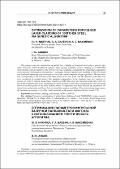| dc.contributor.author | Nikitiuk, Yu. V. | |
| dc.contributor.author | Bayevich, G. A. | |
| dc.contributor.author | Maximenko, A. V. | |
| dc.contributor.author | Aushev, I. Yu. | |
| dc.coverage.spatial | Гомель | ru_RU |
| dc.date.accessioned | 2024-03-27T10:45:42Z | |
| dc.date.available | 2024-03-27T10:45:42Z | |
| dc.date.issued | 2024 | |
| dc.identifier.citation | Parameters optimization of pulsed laser cladding of steel 30KHGSN2A using a genetic algorithm / Yu. V. Nikitiuk [et al.] // Вестник Гомельского государственного технического университета имени П. О. Сухого : научно-практический журнал. – 2024. – № 1. – С. 63–71. | ru_RU |
| dc.identifier.uri | https://elib.gstu.by/handle/220612/32303 | |
| dc.description.abstract | The paper presents the optimization of pulsed laser cladding of structural steel using a genetic algorithm. Using the ANSYS Workbench software, finite element modelling of laser cladding on a 30ХГСН2А
steel substrate with an additive in the form of wire was conducted, considering the temperature dependence
of the material's thermophysical properties. A surrogate model for pulsed laser cladding of 30ХГСН2Аsteel
was developed employing a face-centered version of the central composite design experiment. The time intervals corresponding to the end time of the three fronts of the laser pulse and the diameter of the filler wire
were considered as variable factors. The maximum temperatures in the treatment zone were used as responses. In order to optimize pulsed laser cladding of 30ХГСН2А steel, the maximum temperature limit values in the treatment zone were established for three moments of time that corresponded to the laser pulse
fronts at the three points in the finite element model. A comparison was made between the parameters obtained from optimization and those derived from finite element modelling. When determining temperatures,
the maximum percentage error of the results obtained via the genetic algorithm did not exceed 3.5 %. | ru_RU |
| dc.description.abstract | В работе с использованием генетического алгоритма выполнена оптимизация импульсной лазерной наплавки конструкционной стали. Конечно-элементное моделирование лазерной наплавки на основу
из стали 30ХГСН2А присадкой в виде проволоки выполнялось с учетом зависимости теплофизических свойств материала от температуры в программе ANSYS Workbench. С использованием гранецентрированного варианта центрального композиционного плана эксперимента была получена суррогатная
модель импульсной лазерной наплавки стали 30ХГСН2А. В качестве варьируемых факторов эксперимента использовались временные интервалы, соответствующие времени окончания трех фронтов лазерного импульса, и диаметр присадочной проволоки. В качестве откликов использовались максимальные температуры в зоне обработки. Оптимизация импульсной лазерной наплавки стали 30ХГСН2А
выполнялась при задании предельных значений максимальной температуры в зоне обработки для трех
моментов времени, соответствующих фронтам лазерного импульса, в трех точках конечно-элементной модели. Выполнено сравнение параметров, полученных в результате оптимизации, и параметров, полученных в результате конечно-элементного моделирования. При определении температур
максимальная относительная погрешность результатов, полученных с использованием генетического
алгоритма, не превысила 3,5 %. | |
| dc.language.iso | en | ru_RU |
| dc.publisher | ГГТУ им. П.О. Сухого | ru_RU |
| dc.subject | Pulsed laser cladding | ru_RU |
| dc.subject | Optimization | ru_RU |
| dc.subject | MOGA | ru_RU |
| dc.subject | ANSYS | ru_RU |
| dc.subject | Импульсная лазерная наплавка | ru_RU |
| dc.subject | Оптимизация | ru_RU |
| dc.title | Optimization of parameters for pulsed laser cladding of 30ХГСН2А steel via genetic algorithm | ru_RU |
| dc.title.alternative | Оптимизация параметров импульсной лазерной наплавки стали 30ХГСН2А с использованием генетического алгоритма | ru_RU |
| dc.type | Article | ru_RU |
| dc.identifier.udc | 621.791.725 | |
| local.identifier.doi | 10.62595/1819-5245-2024-1-63-71 | |
